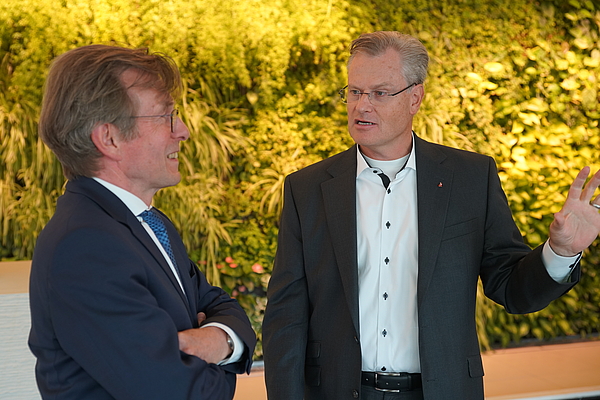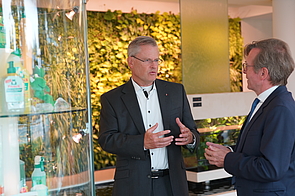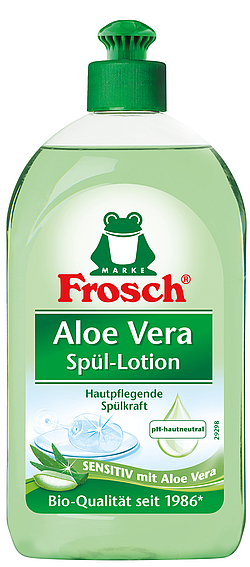

An interview by Barbara and Otto Appel with Reinhard Schneider, CEO of Werner & Mertz GmbH.
When we met Reinhard Schneider in his office in the German city of Mainz at the end of August, the summer heat had already abated. However, it is unlikely that it ever really found its way into the building occupied by Werner & Mertz GmbH. Entering the foyer is like stepping into a biotope, with its imposing hanging garden, trees which seem to grow through the ceiling and a water feature which would delight the frog that is the logo of Frosch, Werner & Mertz’s best-known brand.
Werner & Mertz’s head office, which the company moved into in 2010, is an energy-plus house that meets the latest sustainability criteria. The building was designed with a strong focus on energy efficiency, the indoor climate and eco-friendliness and has won several awards. Schneider will tell us about the building’s holistic nature later. Its energy system comprises a mix of wind energy, photovoltaics and geothermal groundwater, which means that the building generates 20 percent more energy than is needed for its day-to-day running. The energy produced by the rooftop solar installation also powers two electric smart cars, which are used as company vehicles. The heating and cooling system is fed with water from the building’s own well. The water is subsequently demineralised and reused for production purposes in order to conserve resources.

“WHAT IS RECYCLATE?”
Sustainability is a key issue at Werner & Mertz, and their head office is the ideal place in which to discuss it. Schneider quickly turns our conversation to a topic which is weighing heavily on his mind: the definition of recyclate. In the run-up to the introduction of the new German Packaging Law (Verpackungsgesetz) on 1 January 2019, the question is specifically which types of recyclate should be permitted to be used in packaging. Even more importantly, for Schneider, which types of recyclate should be permitted to be labelled as such — and therefore taken into account when calculating licence fees. At first, this may seem to be a very German issue. After all, it is the wording of the new German Packaging Law which has provoked the debate. However, the topic itself is relevant far beyond Germany. For Schneider, the central issue is the difference between post-consumer recyclate (PCR) and post-industrial recyclate. It isn’t the use of post-industrial material to produce packaging that he objects to: “I’m not questioning the act of recycling industrial waste. This is an age-old practice and there’s absolutely nothing wrong with it at all.” Instead, he is concerned by the way this waste is declared.
WHAT IS “POST-INDUSTRIAL RECYCLATE”?
The manufacture of plastic products generates waste, such as trim and startup waste. In the production of plastic bottles via extrusion blow moulding, the waste includes “flash”. This material is recovered for use in industrial production. If it is melted down and used again in the same manufacturing process, it does not count as recycled material. This makes sense, as the material has not been used elsewhere or for any other purpose. Schneider explains the process more clearly by comparing it to making cookies. A cookie cutter is used to cut shapes out of the rolledout dough, and the remaining dough is then kneaded and rolled out again so that more cookies can be cut from it. This continues until — ideally — there is no dough left. Nobody would ever think to call the cookies cut out on the second or third go “special” because they are made from “recycled dough”. Back to the issue of plastic packaging. The situation is different if, instead of being reused in the same manufacturing process, trim waste or flash from bottles etc. is collected and sold, for example to a third-party company, then repurchased as pellets. In this case, it is officially recycled material. The question is, can this material be called recyclate when it is used in newly produced packaging? And can it therefore be included in the proportion of post-consumer recyclate?


“THE GOOD FEELING OF THE CONSUMERS.”
Schneider answers these questions with an unequivocal “no”. And this is where his fight begins. In the ISO standard 14021, post-industrial material is also defined as recyclate. According to the ISO standard, this material can be included in the total proportion of recyclate declared per bottle.
Schneider is not the only one with his eye on the consumer. In its information video on the new German Packaging Law, which is available on YouTube, the Zentrale Stelle Verpackungsregister (Central Packaging Registry) describes how the new legislation will help the environment. The film shows a family shopping, cooking, cleaning and disposing of their rubbish. The rubbish is collected and separated so that all the recyclable materials can be sent for recycling and reuse. What materials do consumers have in mind when they stand in the supermarket and choose a bottle of washing-up liquid which — and they check this carefully — has been deemed to contain, let’s say, 50 percent recyclate? Only the materials which experts refer to as post-consumer recyclate, of course. This makes consumers feel good about themselves, since they have helped to ensure that packaging they have used and correctly disposed of is subsequently recycled and used to produce new packaging; that the plastic they have used will not end up in the environment or the sea, in landfill or incinerators. The higher the proportion of recyclate, the better. This is how the reusable materials cycle is perceived by consumers. It’s a logical, reassuring image.
Schneider is warning against allowing post-industrial material to be counted towards the amount of recyclate in a product, such as the figure of 50 percent in the example above — he sees this as a way of misleading consumers. The makers of information videos, at least, seem to feel the same way. They make no mention of post-industrial material at all.
Section 21 of the new Packaging Law states that packaging will be given preferential treatment based not only on its recyclability, but also on the proportion of recyclate it contains. “Preferential treatment” here means lower licence fees. In light of this, Schneider is not surprised by efforts to ensure that post-industrial material can be included in the proportion of recyclate. He knows from experience that producing high-quality packaging with a high proportion of (post-consumer) recyclate takes a long time and involves a learning curve. He believes that including post-industrial material in the proportion of recyclate would not only deceive consumers, but would also enable manufacturers to cut corners and take shortcuts. It goes without saying that he considers this to be unfair: “I feel that the whole situation is favouring an inefficient production process. Offering these incentives would even reward manufacturers for their inefficiency.” In an extreme-case scenario, this would mean that post-industrial recyclate could crowd out or even replace post-consumer recyclate. “Why? Because companies would be able to advertise a high proportion of recyclate purely by using waste created during production processes,” says Schneider — the ISO standard would allow both post-consumer and post-industrial material to be counted towards the proportion of recyclate declared for a piece of packaging. Schneider believes there is still a chance that the new Packaging Law will define clear rules which will prove benefi cial for post-consumer material and, in turn, for consumers and the environment.
Schneider is highly regarded and well connected, and he makes suggestions and voices his concerns whenever he can. In September 2018, he was invited to the G7 Environment Ministers’ Meeting in Halifax to present Frosch as an example of best practice in the field of resource efficiency. During the event, he explained his view on post-consumer and post-industrial material to the German Federal Minister for the Environment. He is aware that the issue is currently being analysed by an Expert Committee of the newly created Central Packaging Registry. This group of experts is in charge of the handling, observance and monitoring of the environmental objectives. He also knows that it will be the German government which will tip the scales. Schneider had his say in Brussels, too, when he was invited to attend a CEO breakfast during a stakeholder conference in the run-up to the publication of the European Commission’s Strategy on Plastics. As the owner of a medium-sized company, Schneider is often something of an exception in such settings, he says. In Brussels, it became apparent that the large companies were mostly looking to play for time, citing a need for general, international standards, for a liberal approach beginning by holding discussions with international stakeholders at the grassroots level and trying to come to an agreement there. “By the way, we’ve already got started,” interjects Schneider. He then confirms that the technology is advanced enough to produce sustainable packaging containing a high proportion of recyclate which will also sell well. His call for simple raw material — PET which is either colourless or only lightly coloured, and ideally free of barrier materials — has fallen on deaf ears in the detergents and cleaning agents industry.
However, Schneider has more arguments to support his views. In 2012, he founded the multiple award-winning Recyclate Initiative. The idea behind the scheme was to take PET and PE waste from the yellow bags used to collect household packaging waste in Germany, process this into high-quality material and utilise it to produce packaging in a closed material and production cycle. This marked the first time that waste from the yellow bag would be used to manufacture packaging. “Today, we are the world’s leading manufacturer of packaging made from 100 percent recyclate, and we will soon have produced 200 million bottles.” A great deal of time and money went into this success. However, it created an important quality which is now just as intrinsic to the Frosch brand as the biotope is to Werner & Mertz’s head office: credibility. Credibility created through a holistic approach. Frosch emphasises that not only are its products environmentally friendly and sustainable, but the entire brand and all its formulations are free from microplastics. This meant that it was only logical for the company to manufacture its packaging too as sustainably as possible.

THINKING IN CYCLES
The production of plastic packaging using waste from the yellow bag started as an open innovation initiative, the idea being to create a broad foundation. The project began with a call for tender and all system operators in the German waste management industry were invited to take part. The special feature of this call for tender was that it explicitly set out to evaluate the submissions in terms of quality and not cost. The challenge involved was clear, and not just at Frosch. The waste management companies too initially confronted the fundamental problem of sorting. The NIR process used in the waste management industry was not able to sort waste at the level of detail required. However, it did not take long for Reinhard Schneider to find the technology needed to solve this problem. When UNISENSOR won the Deutscher Zukunftspreis (German Future Prize) in 2010, Schneider became aware that this company’s innovative sorting technology would be very useful in helping to produce high-grade recyclate from plastic disposed of in the yellow bag. As part of the open innovation process, a technology platform was then developed in collaboration with the recycling organisation Der Grüne Punkt and the packaging solutions provider ALPLA. “We are not only world leaders in PET, having put almost 200 million bottles into circulation, but have also won prestigious awards for HDPE, as the first company to market Systalen” — Der Grüne Punkt’s brand of recyclates — says Schneider. Frosch plastic bottles are the first to feature PP recyclate caps. “In the future, we are planning to use a special label adhesive during our production processes so that labels can be easily washed off during recycling, in order to keep the negative impact on the quality of the recyclate as low as possible. We have even worked to develop entirely non-toxic printing inks,” adds Schneider. Another example of the company’s holistic approach and ability to think in cycles.
As a supplier of products sold in packaging made from 100 percent post-consumer plastic, Schneider is opposing the declaration and incentivisation of post-industrial plastic; he is wrestling with the retail industry and discussing the matter with competitors and politicians. And he is not afraid to compare the situation to the diesel scandal. NGOs such as Greenpeace, DUH (Environmental Action Germany) and NABU (Nature And Biodiversity Conservation Union) do not yet seem to have addressed the loophole created by the ISO standard, or the option of selling and repurchasing post-industrial material. Schneider believes that if this were to catch the attention of the general public, there would be the risk of a PR disaster, which could result in government intervention. He is convinced that this would harm all market participants and, in any case, would not be at all beneficial for the environment. For him, one thing is certainly clear: only materials which were categorically stopped from entering the environment can be described, declared and incentivised as recyclate. By this he means plastic from used packaging; plastic which is collected as waste and reused.

Lobbyists from the plastic and packaging industries are trying to calm down the heated debate and turn the negative image of plastic packaging on its head. They are appearing on talk shows and explaining its key benefits: packaging protects products, and helps them to last longer, it makes them easier to transport, it helps reduce food waste, etc., etc. Meanwhile, manufacturers are seizing the occasion to emphasise their recycling efforts, and, for example, announcing new objectives like increasing the proportion of recyclate in their packaging. Schneider believes that the industry needs to proceed very carefully in its attempts to give plastic packaging a better reputation. Instead of rehashing the same old arguments or settling for window dressing, the sector needs to make it particularly clear that — contrary to popular opinion — plastic packaging is not at all harmful to the environment if it enters a closed cycle.
With its Recyclate Initiative, Frosch has proven that it is possible and economically feasible for plastic packaging to enter into a closed cycle. Cost is now the only reason why Frosch’s PET packaging is made from just 20 percent plastic obtained from the yellow bag instead of 50 percent. Schneider compares this to a charter flight: the more people who take part, the cheaper it will become for everyone. He would therefore like the entire industry to get involved. Schneider also gives an example of how to improve the reputation of recycled plastic packaging, this time from a market located an extremely long way from Mainz: “Japan is home to the most quality-conscious consumers in the world. We were able to convince Japanese customers that the grey tint of PET bottles made from recycled material, which is visible around the neck where the material is thicker, is not a quality defect, but rather a mark of good quality.” According to Werner & Mertz, 66 percent of people in Japan are familiar with the Frosch brand.
As a sort of litmus test to ascertain whether lobbyists and manufacturers are truly serious about protecting the environment, Schneider likes to ask them whether they are for or against counting post-industrial recyclate towards the proportion of recyclate used in a piece of packaging. Incidentally, post-industrial recyclate is also referred to as “pre-consumer recyclate” — giving it the same abbreviation as post-consumer recyclate: PCR. A coincidence?
The comPETence center provides your organisation with a dynamic, cost effective way to promote your products and services.

magazine
Find our premium articles, interviews, reports and more
in 3 issues in 2025.


